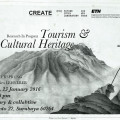Research-in-progress presentation
Tourism & Cultural Heritage
Saturday, 23 January 2016, 6.30 – 8.30 pm
C2O library & collabtive, Jl. Dr. Cipto 22, Surabaya 60264
—————- Scroll down for English version ——————-
Tantangan utama di bidang pariwisata dan urbanisasi adalah objek-objek pengalaman wisata. Seringkali, pertumbuhan industri pariwisata dan pembangunan perkotaan malah menekan dan membahayakan apa yang pada awalnya membuat pariwisata itu sendiri menarik. Perkembangan dari lingkungan, tema, atraksi, dan perjalanan yang signifikan dan bermakna merupakan aspek penting dari pengembangan pariwisata.
Penelitian ini karenanya bertujuan untuk mempelajari—dan mengembangkan—kasus khusus pariwisata pusaka (heritage tourism) di Asia Tenggara.
Fokus mengambil inspirasi pengelana Jerman Franz Wilhelm Junghuhn (1809-1864). Junghuhn menghabiskan hampir seluruh hidupnya sebagai seorang dokter dan penjelajah dalam pelayanan pemerintah kolonial Belanda di pulau Jawa. Warisannya di ranah kartografi, botani, geologi dan menulis hanya dapat dibandingkan dengan peran Thomas Stamford Raffles, Alfred Russel Wallace atau Alexander von Humboldt. Bahkan, ia sering disebut “Humboldt Jawa.” Namun dia tidak banyak dikenal dibandingkan rekan-rekannya, terutama karena tulisan-tulisannya dalam bahasa Belanda dan Jerman. Kami menggunakan Junghuhn sebagai pemandu bayangan dan sebagai figur teladan untuk mengetahui lebih lanjut tentang hubungan antara pariwisata, wisata, penelitian, dan tentang bagaimana situs-situs berubah menjadi pemandangan dan tempat-tempat wisata.
Sehubungan dengan pengumpulan artefak, gambar, dan narasi, proyek ini terdiri dari serangkaian ekspedisi dari Singapura ke Jawa. Setiap ekspedisi membawa sekelompok akademisi internasional dari berbagai bidang, seperti arsitektur, urbanisme, seni, vulkanologi, sejarah sastra, musik, etnografi dan sejarah. Kelompok ini mengikuti jejak Junghuhn. Ruang lingkupnya adalah untuk memahami hubungan antara warisan budaya, lanskap, sejarah politik, seni, dan masyarakat, agar kita dapat secara kritis memahami cara arsitek, dan juga wisatawan pada umumnya, melihat lingkungan mereka dan menampilkan penemuan mereka.
—————— English version ———————
A major challenge in the area of tourism and urbanisation is the object of touristic experience. The rapid growth of tourism and urban development puts the driving force of tourism – its content – under pressure. The development of significant and meaningful environments, themes, attractions and itineraries is an important aspect of fulfilling the demand of tourism. This research project aims to provide more knowledge by studying – and developing – a particular case of heritage tourism in Southeast Asia.
We focus on the German explorer Franz Wilhelm Junghuhn (1809-1864). Junghuhn spent almost his entire life as a doctor and explorer in the service of the Dutch colonial authorities on the island of Java. His legacy in the realm of cartography, botany, geology and writing can only be compared to the role of Thomas Stamford Raffles, Alfred Russel Wallace or Alexander von Humboldt. In fact, he was often called the “Humboldt of Java” but he remains in the shadow of his famous peers mainly because his writings were exclusively in Dutch and German. We use Junghuhn as an imaginary guide and as an exemplary figure in order to find out more about the relation between tourism, travel, research, and about the way sites have been transformed into sights and tourist attractions.
In view of accumulating artifacts, images, and narratives, the project consists of a series of expeditions from Singapore to Java. Each expedition features a group of international scholars from different fields, such as architecture, urbanism, art, volcanology, literary history, music, ethnography and history. The groups follow the traces of Junghuhn. The scope is to understand connections between cultural heritage, landscape, political history, art, and society and to critically reflect the way architects, but also tourists in general, travel, perceive their environment and represent their discoveries.
Prof Dr Philip Ursprung is Professor of the History of Art and Architecture at ETH Zürich since 2011 and Designated Dean of the Department of Architecture. He earned his PhD in Art History at Freie Universität Berlin in 1993 after studying in Geneva, Vienna and Berlin and his Habilitation at ETH Zurich in 1999. He taught at the University of Geneva, the Hochschule der Künste Berlin, the GSAPP of Columbia University New York, the Barcelona Institute of Architecture and the University of Zürich.
Philip Ursprung served as advisor to the Swiss Federal Government as member of the Eidgenössische Kunstkommission from 1997 to 2004. He was president of the Fondation Nestlé pour l’Art from 2003 to 2014 and president of the Jury of Akademie Schloss Solitude in Stuttgart from 2007-2011. Since 2013 he is president of the scientific board of Zentralinstiut für Kunstgeschichte in Munich.
INFO: www.fcl.ethz.ch



Leave a Reply